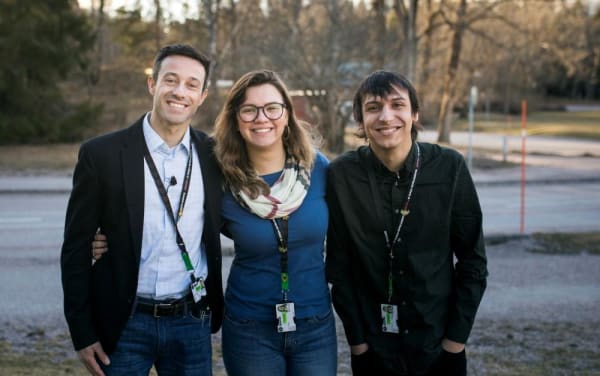Technology exchange for highflying avionics
Arboga, Sweden. Saab’s deliveries to Brazil go way beyond the Gripen fighters. Even before the multirole fighter takes to the skies, the technical and cultural exchange between the two countries is already intense. Since January 2017, engineers from AEL Sistemas have been in Arboga to learn in detail the concept developed by Saab for the automatic test equipment(ATE) and for maintaining the avionics units on the aircraft.
The low building in an industrial area in Arboga reveals nothing about the high level of technical interaction between Swedish and Brazilian engineers that goes on inside. For seven months, Marcelo Tonial and his two colleagues from AEL Sistemas are spending their days developing the knowledge on how to build and optimize the resources required to maintain the avionics units on Gripen. They are there to acquire the knowledge required to set up a workshop in Brazil for maintaining 36 Gripen fighters ordered for the Brazilian Air Force. “Going to Sweden for the technology transfer process was something I really wanted to be involved in,” says Tonial, who has temporarily left his position at the Research and Development department at AEL Sistemas to lead the Brazilian team in Sweden.

Pernilla Löfgren and Marcelo Tonial
Marcelo Tonial and his colleagues are only three of nearly 350 professionals from Saab's Brazilian partner companies and the Brazilian Air Force that are involved in the Transfer of Technology (ToT), the industrial cooperation and technical exchange programme between the two countries that began in October 2015 and will last until 2024. The aim is to provide the Brazilian aerospace industry with the technology and knowledge needed to develop, assemble and maintain Gripen in Brazil.
In the technology transfer program, the sharing of knowledge goes two ways. AEL Sistemas develops and manufactures technological solutions for defence and security in air and on land and has developed the electronic display for the Gripen aircraft in Brazil.
“The panoramic screen is an important project for our company and our group is responsible for the test equipment for this piece of avionics,” Tonial says. “Beyond that, I believe we also can suggest some new system solutions to benefit Saab. We hope that the longer we are here, the more input we will be able to offer.” For Saab the Transfer of Technology programme is a huge win-win, according to Jörgen Ekstedt, Senior Project Manager at Saab, who is responsible for the exchange.
“It’s great to get new perspectives on what we do,” he says. “Clearly everyone benefits from this. Marcelo and his team have contributed by making improvements to our designs. But an important part of the Transfer of Technology programme is everyone having a chance to learn about our different ways of working, not just in terms of methodologies and processes, but our cultural differences as well, which improves our understanding and cooperation.”
As Jörgen Ekstedt points out, while the Swedes may find Brazilian organisations hierarchical, the Brazilians seem to embrace the more horizontal orientation of Swedish organisations and their eagerness to build consensus. At least, he said, when it comes to the engineers working in Arboga.
“The more horizontally oriented structure allows information to flow between everyone involved in the project,” says Tonial. “It’s a great advantage and brings more ideas to the table. This is an experience that I will definitely take back with me to Brazil.”
The cultural exchange extends way beyond office hours. Besides having designated mentors for activities, visitors are allocated buddies, who are volunteers from other departments of Saab responsible for making sure that they get a chance to interact and socialize with other Swedes outside the company.
“My buddy is a football trainer, so I’ve spent several evenings playing football, which is fun. But the best part for sure has been the snowboarding, which is a bit painful, but great. My next brave step will be to try surströmming, the Swedish fermented fish ‘delicacy’ that everyone has warned me about,” Tonial says, with a wide smile.

Brazilian engineers:
Marcelo Tonial, 33, Team Leader
Joaõ Metinger, 27, Software Engineer
Morgana Cardoso, 25, Hardware Developer
Best things about Sweden:
Marcelo Tonial:
- Snowboarding
- Recycling
- Equality
- Safety
- The way you talk to children – like they are grown-ups
Morgana Cardoso:
- Allemansrätten, the general public's right to access the vast Swedish countryside for recreation and exercise
- Respect for women and equality
Joaõ Metinger:
- The freedom to walk anywhere as long as you show respect for the environment
- Ice skating on a real lake!
Most important things learned from the Transfer of Technology programme:
Marcelo Tonial:
- The flat organisation
- The Model to Develop Maintenance Resource, MDMR, the detailed process that ensures that every necessary step is included in the development of a maintenance resource.
Morgana Cardoso:
- Consensus – that you can discuss everything and that you listen to each other and can finish with an agreed consensus. But that also means that everyone has to be prepared and bring something to the discussion
- The flat organisation: that everyone is being listened to.
Joaõ Metinger:
- The flat organisation where everyone’s opinion matters. That makes it easier to find good solutions to problems
- The Model to Develop Maintenance Resource, MDMR. It’s detailed and makes you check every step in the development of a maintenance resource.
Others pictured are the Saab mentors Pernilla Löfgren and Mikael Lindeman.

From the left: Morgana Cardoso,Joaõ Metinger, Mikael Lindeman,Pernilla Löfgren,Jörgen Ekstedt,Marcelo Tonial.